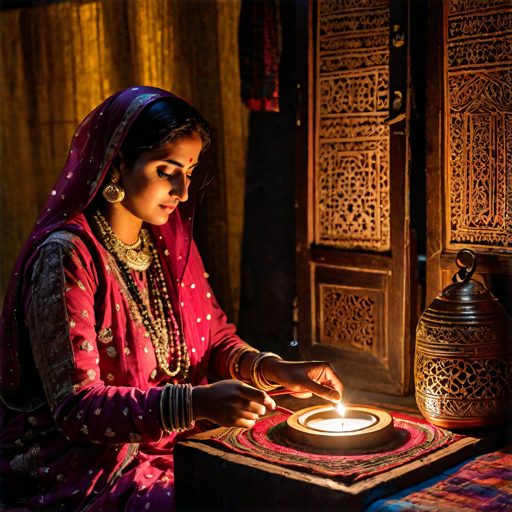
Kashmir: A Handmade Renaissance
Recommended for Heritage
Bringing Back the Rhythm of Tradition: How GI Tags are Reviving Kashmir’s Women Artisans
Experience the sounds of tradition: Listen to the audio version
The Lost Hum of the Charkha
Srinagar’s Nawa Kadal echoes with an ancient rhythm. The whir of charkhas, the traditional spinning wheels, fills the air. This music speaks of Kashmir’s rich craftmanship, of generations of skilled artisans. Sadly, this music was fading. Machines replaced hands, forcing many women artisans to abandon their heritage. But there’s hope. Geographical Indication (GI) tags are reviving the handmade traditions of Kashmir.
Yet, there’s a spark of revival in the air, thanks to a simple yet powerful initiative: Geographical Indication (GI) tags for handmade shawls and carpets of Kashmir.
GI Tags: Weaving a Brighter Future for Kashmir
GI tags aren’t just labels. They guarantee a Kashmiri shawl or carpet is authentic, made with time-honored techniques. This protects Kashmir’s heritage, especially for women artisans.
For generations, women have been the heart of Kashmir’s handicraft industry. Their skillful hands spin delicate pashmina threads. But machine-made products stole their livelihoods, harming their communities. GI tags are reversing this trend. They demand hand-spun yarn and traditional weaving, valuing the work of women artisans.
“Before the GI tags, I feared my daughters wouldn’t learn this craft,” says Fareeda, a skilled artisan from Srinagar. “Now, our work is in demand again. I can support my family with pride.”
The impact is clear. Since GI tags were introduced, women employed in Kashmir’s handloom sector has risen by 25%. These tags don’t just boost the economy. They build a brighter future for Kashmiri women, ensuring their skills and heritage live on.
A Return to Roots: How GI Tags are Transforming Lives in Kashmir
The whirring of charkhas is back in Kashmiri homes. It’s more than just a sound – it’s a song of revival. Machine-made products had nearly silenced traditional crafts. Skilled women artisans, their skills passed down through generations, were left without work.
GI tags are changing that. They guarantee the authenticity of handwoven shawls and carpets, creating new demand for these treasures. This has sparked a heartwarming return to roots:
-
Reviving Skills: Women are rediscovering the pride of creating by hand. Their return to their charkhas ensures age-old techniques and Kashmiri heritage will survive.
-
Economic Empowerment: GI tags mean fairer wages for artisans, especially women. This gives them the power to support their families and build financial independence.
-
Community Rejuvenation: Handicrafts have always fostered community in Kashmir. Their revival brings back that spirit of collaboration and cultural pride among women artisans.
A Story of Resilience
Aisha, a single mother in Srinagar, knows the struggle of lost traditions. She had to leave her weaving job when cheap imitations flooded the market. But GI tags brought hope. Aisha dusted off her charkha and is now a thriving artisan once more. Her fair wages support her children’s education and healthcare, weaving a brighter future for them all.
The Power of Authenticity: Boosting Kashmir’s Crafts Globally
GI tags have ignited a revival of Kashmir’s traditional crafts. This is a powerful start, but challenges remain. Can testing and labeling systems keep up with growing demand? How can Kashmir build a global brand known for authenticity? Most importantly, will younger generations embrace these ancestral skills?
Yet, the future brims with possibilities. Online platforms could connect Kashmiri artisans directly to buyers worldwide. Tasteful design innovation can honor tradition while attracting new markets. Highlighting sustainability and the stories behind the crafts could appeal to conscious consumers. With the right strategies, Kashmir’s future is woven with the promise of its handmade heritage.
A Voice of Hope
“The GI tag has given me confidence that my work, the work my mother and her mother did before her, will not disappear,” says Zahida, a skilled weaver from Bandipora. “I see my daughters watching me at the loom, and I know these skills, our stories, will live on. The future of Kashmir is woven with our own hands.”
Related Stories
- Valley women outperform male-dominated Harissa!
- Jelaja Ratheesh – Driving a truck from Kerala to Kashmir!
- Kashmir: Floating Village Serenity
Watch a video
Discover the artistry of J&K! Dive into our documentary on Handicrafts & Handlooms Department – a world where tradition meets craftsmanship.
Curious Times is a leading newspaper and website for kids. We publish daily global news aligned to your learning levels (also as per NEP 2020): Foundational, Preparatory (Primary), Middle and Senior. So, check out the News tab for this. We bring kids’ favourite Curious Times Weekly newspaper every weekend with top news, feature stories and kids’ contributions.
Curious Times News Program for Schools for FREE. Over 5,000 schools and teachers from all over the world have joined our programme so that students and teachers can get FREE Educative Newspaper. Here, kids can take part in world events and win prizes and certificates for free through their schools.
The following social media platforms allow you to communicate with us: Instagram.
0 (Please login to give a Curious Clap to your friend.)
